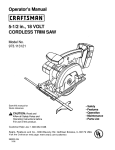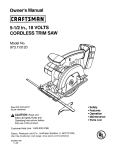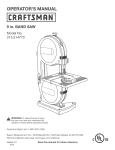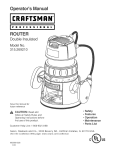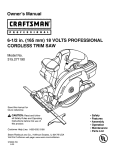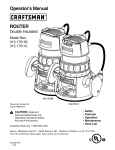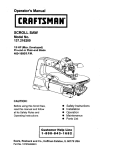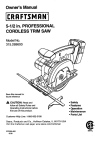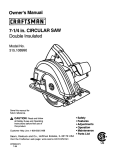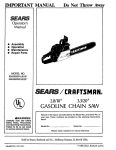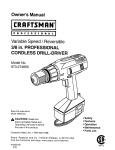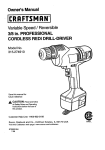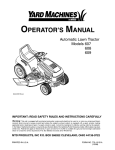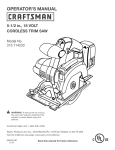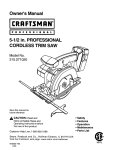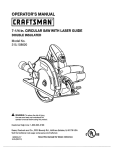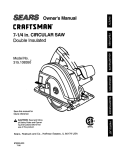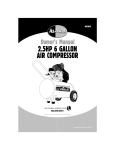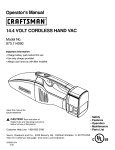Download Craftsman 973.113080 Owner`s manual
Transcript
Owner's Manual CRFIFTSMI:IN I 5-1/2 in., 14.4 VOLTS CORDLESS TRIM SAW Model No. 973.113080 Save this manual future reference for • • • • • CAUTION: Read and follow all Safety Rules and Operating Instructions before first use of this product. Customer Help Line: 1-800-932-3188 Sears, Roebuck and Co., Hoffman Estates, IL 60179 Visit the Craftsman web page: www.sears.com/craftsman 972000-806 10-00 Safety Features Operation Maintenance Parts List USA ® • Table of Contents ........................................................................................................................................... 2 • Warranty and Introduction .............................................................................................................................. 2 • Rules For Safe Operation ........................................................................................................................... 3-6 A. Important Safety Rubes For Battery Tools .............................................................................................. 4 B. Important Safety Instructions For Charger ............................................................................................. 4 C. Important Safety Instructions For Trim Saws ......................................................................................... 5 • Product Specifications • Accessories • Features ............. :...._..................................................................................................................................... • Operation .................................................................................................................................................. • Maintenance ................................................................................................................................................ 17 • Battery Pack Removal and Preparation For Recycling ................................................................................ 17 • Exploded View and Repair Parts List ...................................................................................................... • Parts Ordering / Service ............................................................................................................................... _1_ and Unpacking .......................................................................................................... 6 ................................................................................................................................................... Look for this symbol safety is involved. to point out important FULL ONE YEAR WARRANTY ON CRAFTSMAN safety precautions. It means attention!H 6 7 8-16 18-19 20 Your CORDLESS TRIM SAW If this CRRI=TSMRNCordless Trim Saw fails to give complete satisfaction within one year from the date of purchase, RETURN IT TO THE NEAREST SEARS STORE OR SEARS SERVICE CENTER IN THE UNITED STATES, and Sears will repair it, free of charge, If this I"RAFTSI_I_N Trim Saw is used for commercial from the date of purchase. or rental purposes, this warranty applies for only 90 days This warranty gives you specific legal rights, and you may also have other rights which vary from state to state. Sears, Roebuck and Co., Dept. 817WA, Hoffman Estates, IL 60179 Your trim saw has many features for making cutting operations more pleasant and enjoyable. Safety, performance and dependability have been given top priority in the design of this trim saw making it easy to maintain and operate. ,_ _, CAUTION: Carefully read through this entire owner's manual before using your new trim saw. Pay close attention to the RuLes For Safe Operation, Warnings and Cautions. tf you use your trim saw properly and only for what it is intended, you will enjoy years of safe, reliable service. WARNING: The operation of any power tool can result in foreign objects being thrown into your eyes, which can result in severe eye damage. Before beginning power tool operation, always wear safety goggles or safety glasses with side shields and a full face shield when needed. We recommend Wide Vision Safety Mask for use over eyeglasses or standard safety glasses with side shields, available at Sears Retail Stores. The purpose of safety symbols is to attract your attention to possible dangers. The safety symbols, and the explanations with them, deserve your careful attention and understanding. The safety warnings do not by themselves eliminate any danger. The instructions or warnings they give are not substitutes for proper accident prevention measures. SYMBOL ,& MEANING SAFETY ALERT SYMBOL: Indicates danger, warning or caution. May be used in conjunction with other symbols or pictographs. A DANGER: Failure to obey a safety warning will result in serious injury to yourself or to others. Always folJow*the safety precautions to reduce the risk of fire, electric shock and personal injury. A WARNING: Failure to obey a safety warning can result in serious injury to yourself or to others. Always follow the safety precautions to reduce the risk of fire, electric shock and personal injury. A CAUTION: Failure to obey a safety warning may result in property damage or personal injury to yourself or to others. Always follow the safety precautions to reduce the risk of fire, electric shock and personal injury. NOTE: Advises you of information or instructions vital to the operation or maintenance of the equipment. _k WARNING: Do not attempt to operate this tool until you have read thoroughly and understand completely all instructions, safety rules, etc. contained in this manual. Failure to comply can result in accidents involving fire, electric shock, or serious personal injury. Save owner's manual and review frequently for continuing safe operation, and instructing others who may use this tool. • USE RIGHT TOOL. Don't force small tool or attachment to do the job of a heavy duty tool. Don't use tool for purpose not intended - for example - A circular saw should never be used for cutting tree limbs or logs. • READ ALL INSTRUCTIONS KNOW YOUR POWER TOOL. Read owner's manual carefully. Learn its applications and limitations as well as the specific potential hazards related to this tool. GUARD AGAINST ELECTRICAL SHOCK by preventing body contact with grounded surfaces. For example: Pipes, radiators, ranges, refrigerator enclosures. • KEEP WORK AREA CLEAN. Cluttered areas and benches invite accidents. • AVOID DANGEROUS ENVIRONMENT. Don't use power tool in damp or wet locations or expose to rain. Keep work area well lit. WEAR PROPER APPAREL. Do not wear loose clothing or jewelry that can get caught in tool's moving parts and cause personal injury. Rubber gloves and nonskid footwear are recommended when working outdoors. Wear protective hair covering to contain long hair and keep it from being drawn into nearby air vents. ALWAYS WEAR SAFETY GLASSES. Everyday eyeglasses have only impact-resistant lenses; they are NOT safety glasses. PROTECT YOUR LUNGS. Wear a face mask or dust mask if operation is dusty. PROTECT YOUR HEARING. Wear hearing protection during extended periods of operation. SECURE WORK. Use clamps or a vise to hold work. It's safer than using your hand and it frees both hands to operate tool. KEEP CHILDREN AND VISITORS AWAY. All visitors should wear safety glasses and be kept a safe distance from work area. Do not let visitors contact tool or extension cord. • DON'T FORCE TOOL. It will do the job better and safer at the rate for which it was designed. DON'T OVERREACH. Keep proper footing and balance at all times. Do not use while standing on a ladder or unstable support. STORE IDLE TOOLS. When not in use tools should be stored in a dry and high or locked-up place - out of the reach of children. 3 RULES FOR SAFE OPERATION (Continued) making adjustments to it, or when changing accessories. MAINTAIN TOOLS WITH CARE. Keep tools sharp at all times, and clean for best and safest performance. Follow instructions for lubricating and changing accessories. USE ONLY THE CHARGER PROVIDED WITH YOUR BATTERY TOOL. Do not substitute any other charger. Use of another charger could cause batteries to explode causing possible serious injury. REMOVE ADJUSTING KEYS AND WRENCHES. Form habit of checking to see that keys and adjusting wrenches are removed from tool before turning it on. DO NOT PLACE BATTERY TOOLS OR THEIR BATTERIES NEAR FIRE OR HEAT. They may explode. NEVER USE IN AN EXPLOSIVE ATMOSPHERE. Normal sparking of the motor could ignite flammable liquids, gases, or fumes. DO NOT CHARGE BATTERY TOOL IN A DAMP OR WET LOCATION. KEEP HANDLES DRY, CLEAN, AND FREE FROM OIL AND GREASE. Always use a clean cloth when cleaning. Never use brake fluids, gasoline, petroleum-based products or any strong solvents to clean your tool. • Your battery tool should be charged in a location where the temperature is more than 50°F but less than 100°F. Under extreme usage or temperature conditions, battery leakage may occur. If liquid comes in contact with your skin, wash immediately with soap and water, then neutralize with lemon juice or vinegar. If liquid gets in your eyes, flush them with clean water for at least 10 minutes, then seek immediate medical attention. STAY ALERT. Watch what you are doing and use common sense. Do not operate tool when you are tired. Do not rush. CHECK DAMAGED PARTS. Before further use of the tool, a guard or other part that is damaged should be carefully checked to determine that it • • will operate properly and perform its intended function. Check for alignment of moving parts, binding of moving parts, breakage of parts, mounting, and any other conditions that may affect its operation. A guard or other part that is damaged should be properly repaired or • If carrying your battery tool at your side, make sure it is not running and your finger is not on the switch. Avoid accidental starting. • SECURE WORK before applying power. NEVER hold workpiece in your hand or across your legs. replaced by an authorized service center unless indicated elsewhere in this instruction manual. • WHEN SERVICING USE ONLY IDENTICAL CRAFTSMAN REPLACEMENT PARTS. DO NOT USE TOOL IF SWITCH DOES NOT TURN IT ON AND OFF. Have defective switches replaced by an authorized service center. IMPORTANT • Before using battery charger, read all instructions and cautionary markings in this manual, on battery charger, and product using battery charger. Do not expose charger to rain or snow. before cutting. SAFETY Use of an attachment not recommended RULES FOR WARNING: To reduce risk of injury, charge only nickel-cadmium type rechargeable batteries. Other types of batteries may burst causing personal injury and damage. INSPECT FOR and remove all nails from lumber IMPORTANT TOOLS INSTRUCTIONS SAVE THESE INSTRUCTIONS. This manual contains important safety and operating instructions for battery charger item number 9-11012 (981481-001 ). DRUGS, ALCOHOL, MEDICATION. Do not operate tool while under the influence of drugs, alcohol, or any medication. CUTTING INTO ELECTRICAL WIRING IN WALLS AND FLOORS CAN CAUSE THE BLADE AND METAL PARTS TO BECOME ELECTRICALLY LIVE. Do not touch metal parts when cutting into walls and floors; grasp only the insulated handle(s) provided on the tool. Make sure hidden electrical wiring, water pipes, and mechanical hazards are not in the blade path when cutting into a wall or floor. • SAFETY CHARGER FOR BATTERY or sold by the battery charger manufacturer may result in a risk of fire, electric shock, or injury to persons. Battery tools do not have to be plugged into an electrical outlet; therefore, they are always in an operating condition. Be aware of possible hazards when carrying your battery tool, when To reduce risk of damage to charger body and cord, pull by charger body rather than cord when disconnecting charger. 4 RULES • • FOR SAFE OPERATION (Continued) Make sure cord is located so that it will not be stepped on, tripped over, or otherwise subjected • KEEP BLADES CLEAN AND SHARP. Sharp blades minimize stalling and kickback. to damage or stress. An extension cord should not be used unless absolutely necessary. Use of improper extension cord could result in a risk of fire and electric shock. If extension cord must be used, make sure: • KEEP HANDS AWAY FROM CUTTING AREA. Keep hands away from blade. Do not reach underneath work while blade is rotating. Do not attempt to remove cut material when blade is moving. a. _i, • That pins on plug of extension cord are the same number, size and shape as those of plug on charger. b. That extension cord is properly wired and in good electrical cSndition; and c. That wire size is large enough for AC ampere rating of charger as specified below: Cord Length (Feet) 25' 50' 100' Cord Size (AWG) 16 16 16 Note: AWG = American Wire Gage • DO NOT OPERATE CHARGER WITH A DAMAGED CORD OR PLUG. If damaged, have replaced immediately by a qualified service technician. • Do not operate charger if it has received a sharp blow, been dropped, or otherwise damaged in any way; take it to a qualified service technician. • Do net disassemble charger; take it to a qualified service technician when service or repair is required. Incorrect reassembly may result in a risk of electric shock or fire. • To reduce risk of electric shock, unplug charger from outlet before attempting any maintenance or cleaning. Turning off controls will not reduce this risk. • Do not use charger outdoors. • Disconnect charger from power supply when net in use. IMPORTANT TRIM SAWS SAFETY INSTRUCTIONS FOR KEEP GUARDS IN PLACE AND IN WORKING ORDER. Never wedge or tie lower blade guard open. Check operation of lower blade guard before each use. Do not use if lower blade guard does not close briskly over saw blade. _k WARNING: If saw is dropped, lower blade guard or bumper may be bent, restricting full return. If lower blade guard or bumper becomes bent or damaged, replace them before reuse. WARNING: Blades coast after turn off. USE RIP FENCE. Always use a fence or straight edge guide when ripping. SUPPORT LARGE PANELS. To minimize the risk of blade pinching and kickback, always support large panels as shown in Figure 9, Page 11. When cutting operation requires the resting of the saw on the workpiece, the saw should be rested on the larger portion and the smaller piece cut off. • LOWER BLADE GUARD. _k WARNING: If lower blade guard must be raised to make a cut, always raise it with the retracting handle to avoid serious injury. See Figure 21, Page 16. • GUARD AGAINST KICKBACK. Kickback occurs when the saw stalls rapidly and is driven back towards the operator. Release switch immediately if blade binds or saw stalls. Don't remove saw from work during a cut while the blade is moving. See Pages 11 and 12. • BEFORE MAKING A CUT, BE SURE THE DEPTH AND BEVEL ADJUSTMENTS ARE TIGHT. • USE ONLY CORRECT BLADES. Do not use blades with incorrect size holes. Never use blade washers or bolts that are defective or incorrect. The maximum blade capacity of your saw is 5-1/2 inches. NEVER touch the blade or other moving parts during use. NEVER start a saw when its blade is touching the workpiece. NEVER lay a tool down before its moving parts have come to a complete stop. SAVE THESE INSTRUCTIONS. Refer to them frequently and use them to instruct others who may use this tool. If you loan someone this tool, loan them these instructions also. _IWARNING: Somedustcreatedby powersanding,sawing,grinding,drilling,andotherconstruction activitiescontainschemicalsknownto causecancer,birthdefectsor otherreproductive harm.Some examples of these chemicals are: • lead from lead-based • crystalline paints, silica from bricks and cement and other masonry products, and • arsenic and chromium from chemically-treated lumber. Your risk from these exposures varies, depending on how often you do this type of work. To reduce your exposure to these chemicals: work in a wen ventilated area, and work with approved safety equipment, such as those dust masks that are specially designed to filter out microscopic particles. SAVE THESE INSTRUCTIONS Blade Diameter 5-1/2 in. Blade Arbor 3/8 in. Cutting Depth at 0 ° Bevel Cut Cutting Depth at 45 ° Bevel Cut 1-9/16 in. 1-1/8 in. Your trim saw has been shipped completely assembled except for the blade. Inspect it carefully to make sure no breakage or damage has occurred during shipping. If any parts are damaged or missing, contact your nearest Sears Retail Store to obtain replacement parts before attempting to operate saw. A blade, blade wrench, rip guide, and this owner's manual are also included. The following recommended • ,_i 5-1/2 in. WARNING: No Load Speed Motor Charge Rate Charger Rating 3,800 RPM 14.4 Volts DC 3 - 5 Hours 120 volts, 60 Hz, AC WARNING: If any parts are missing, do not operate this tool until the missing parts are replaced. Failure to do so could result in possible serious personal injury. accessories are currently available at Sears Retail Stores. Thin Kerr Blade The use of attachments or accessories not listed might be hazardous. KNOWYOURTRIM SAW SWITCH See Figure 1. See Figure 1. Before attempting to use any tool familiarize yourself with all operating features and safety requirements. Your saw is equipped with a lock-off button which reduces the possibility of accidental starting. The lockoff button is located on the handle above the switch trigger. You must depress the lock-off button in order to pull the switch trigger. The lock resets each time the trigger is released. Note: You can depress the lock-off button from either the left or right side. Features include easily operated bevel cut and depth of cut adjustment mechanisms; positive 0 ° bevel stop; spindle lock; and blade wrench storage, _1 WARNING: If any parts are missing, do not operate tool until the missing parts are replaced. Failure to do so could result in possible serious personal injury. APPLICATIONS (Use only for the purpose • listed below) Cutting all types of wood products (lumber, plywood, paneling). CHARGER RIP GUIDESCREW (WINGSCREW) BATTERY PACK RED LIGHT BLADEWRENCH STORAGEAREA BLADEWRENCH (5 mm HEXKEY) DEPTHOF CUT ADJUSTMENT (DEPTHADJUSTMENTKNOB) LOCK-OFF BUTTON SPINDLE LOCK BUTTON CHARGING STAND RIP GUIDESCREW (WINGSCREW) SWITCH TRIGGER UPPER BLADEGUARD -LOWER BLADEGUARD BEVELCUT ADJUSTMEN1 (BEVELADJUSTMENT KNOB) 'BLADE RIP GUIDE BASE ASSEMBLY Fig. t 7 ,_ _i WARNING: Always wear safety goggles or safety glasses with side shields when operating tools. Failure to de so could result in objects being thrown into your eyes, resulting in possible serious injury. WARNING: Do not allow familiarity with your trim saw to make you careless. Remember that a careless fraction of a second is sufficient to inflict severe injury. CHARGING BATTERY • Connect charger to power supply. • Place battery pack in charging stand. Align raised rib on battery pack with groove in charging stand. See Figure 1. • Press down on battery pack to be sure contacts on battery pack engage properly with contacts in charging stand. • When properly connected, the red light on charging stand will turn on. • Note: If charger does not charge battery pack, return battery pack, charger and charging stand to your nearest Sears Repair Center for electrical check. • After normal usage, 3 hours of charging time is required to be fully charged. A minimum charge time of 3 to 5 hours is required to recharge a completely discharged tool. • The battery pack will become slightly warm to the touch while charging. This is normal and does not indicate a problem. • Do not place charger in an area of extreme heat or cold. It will work best at normal room temperature. • When batteries become fully charged, unplug charger from power supply. PACK The battery pack for this tool has been shipped in a low charge condition to prevent possible problems. Therefore, you should charge it at least 3 to 5 hours prior to use. Note: Batteries will not reach full charge the first time they are charged. Allow several cycles (cutting followed by recharging) for them to become fully charged. TO CHARGE • Charge battery pack only with the charger and charging stand provided, • Make sure power supply is normal household voltage, 120 volts, 60 Hz, AC only. ,_ WARNING: Always remove battery pack from your saw when you are assembling parts, making adjustments, assembling or removing blades, cleaning, or when not in use. Removing battery pack will prevent accidental starting that could cause serious personal injury. TO REMOVE • BATTERY ,_ engage with the flats on the spindle. Larger blades will come in contact with the blade guard, while thicker blades will prevent blade screw from securing blade on spindle. Either of these situations could result in a serious accident. PACK Locate latches on end of battery pack and depress to release battery pack from your saw. See Figure 2. DEPRESSLATCHESTO RELEASEBATrERYPACK WARNING: A 5-1/2 in. blade is the maximum blade capacity of your saw. Never use a blade that is too thick to allow outer blade washer to TO ASSEMBLE OR REMOVE BLADE TO ASSEMBLE BLADE: • Remove battery pack from saw. _1= WARNING: Failure to remove battery pack from saw could result in accidental starting causing possible serious personal injury. • Locate latches on end of battery pack and depress to release battery pack from your saw. See Figure 2. • Remove blade wrench (5 mm hex key) from storage area. See Figure 1. • Depress spindle lock button and remove blade screw and outer blade washer. See Figure 3. LATCHES SPINDLE LOCKBUTTON BATTERY PACK Fig. 2 • Remove battery pack from your saw. TO INSTALL BATTERY PACK See Figure 2. • • ,_ Place battery pack in your saw. Align raised rib inside saw with groove on battery pack. Make sure the latches on each side of your battery pack snap in place and battery pack is secured in saw before beginning operation. CAUTION: When placing battery pack in your saw, be sure raised rib inside saw aligns with groove on battery pack and latches snap in place properly. Improper assembly of battery pack can cause damage to internal components. LOWERBLADE GUARDHANDLE BLADE OUTER BLADE BLADE SCREW WASHER Fig. 3 Note: Turn blade screw clockwise to remove. • _L Wipe a drop of oil onto inner blade washer and outer blade washer where they contact blade. WARNING: If inner blade washer has been removed, replace it before placing blade on spindle. Failure to do so could cause an accident since blade will not tighten properly. • Fitsawbladeinsidelowerbladeguardandonto spindle.Note:Thesawteethpointupwardatthe frontof sawasshownin figure3. • Replaceouterbladewasher. • Depressspindlelockbutton,thenreplaceblade screw.Tightenbladescrewsecurely. Note:Turnbladescrewcounterclockwise totighten. • Returnbladewrenchto storagearea. REMEMBER: SAW BLADES The best of saw blades will net cut efficiently if they are not kept clean, sharp, and properly set. Using a dull blade will place a heavy load on your saw and increase the danger of kickback. Keep extra blades on hand, so that sharp blades are always available. Gum and wood pitch hardened on blades will slow your saw down. Use gum and pitch remover, hot water, or kerosene to remove these accumulations. Do not use gasoline. Never use a blade that is too thick to allow the outer blade washer to engage with the flats on the spindle, BLADE TO REMOVE BLADE: The lower blade guard attached to your trim saw is there for your protection and safety, It should never be altered for any reason. If it becomes damaged or begins to return slow or sluggish, do not operate your saw until the damage has been repaired or replaced. Always leave guard in operating position when using saw. • Remove battery pack from saw. _l_ WARNING: Failure to remove battery pack from saw could result in accidental starting causing possible serious personal injury. • Remove blade wrench from storage area. See Figure 1. • Position your saw as shown in figure 4, depress spindle lock button, and remove blade screw. • ,_ Note: Turn blade screw clockwise to remove. Remove outer blade washer. See Figure 3. Note: Blade can be removed at this point. SPINDLE LOCK BUTTON GUARD SYSTEM DANGER: When sawing through workpiece, lower blade guard does not cover blade on the underside of workpiece. Since blade is exposed on underside of workpiece, keep hands and fingers away from cutting area. Any part of your body coming in contact with moving blade will result in serious injury. See Figure 5. LOWERBLADEGUARD IS IN UP POSITION WHENMAKINGA CUT BLADE SCREW \ BLADEEXPOSEDON UNDERSIDEOF WORKPIECE .BLADE WRENCH Fig. 5 Never use saw when guard is not operating correctly, Guard should be checked for correct operation before each use. If you drop your saw, check the lower blade guard and bumper for damage at all depth settings before reuse. Fig. 4 Note: The guard is operating correctly when it moves freely and readily returns to the closed position. If for any reason your lower blade guard does not close freely, take it to the nearest Sears Parts and Repair Center for service before using. 10 KICKBACK TO LESSEN See Figure 6. • BLADESETTOO DEEP* THE CHANCE OF KICKBACK: Always keep the correct blade depth setting - the correct blade depth setting for all cuts should not exceed 1/4 in. below the material to be cut. See Figure 8. One blade tooth below the material to be cut works best for most efficient cutting action. Fig. 6 The best guard against kickback is to avoid dangerous practices. Kickback occurs when the blade stalls rapidly and the saw is driven back towards you. Blade stalling is caused by any action which pinches the blade in the wood. _i KICKBACK IS CAUSED BY: • Incorrect blade depth setting. See Figure 6. • Sawing into knots or nails in workpiece. • Twisting blade while making a cut. • Making a cut with a dull, gummed up, or improperly set blade. • CORRECTBLADEDEPTHSETTING= BLADEEXPOSEDONEBLADETOOTH BELOWTHE MATERIALTO BE CUT DANGER: Release switch immediately if blade binds or saw stalls. Kickback could cause you to lose control of your saw. Loss of control can lead to serious injury. • Inspect the workpiece for knots or nails before beginning a cut. Never saw into a knot or nail. • Make straight cuts. Always use a straight edge guide when rip cutting. This helps prevent twisting the blade in the cut. Always use clean, sharp and properly set blades. Never make cuts with dull blades. To avoid pinching the blade, support the workpiece properly before beginning a cut. The right and wrong ways to support large pieces of work are shown in figures 7 and 9. Incorrectly supporting workpiece. See Figure 7. RIGHT Fig. 7 • Forcing a cut. • Cutting warped or wet lumber. • Tool misuse or incorrect operating procedures. Fig. 8 11 Fig. 9 • Whenmakinga cutusesteady,evenpressure. Neverforcecuts. • Donotcutwarpedor wetlumber. • Alwaysholdyoursawfirmlywithbothhandsand keepyourbodyin a balancedpositionso asto resisttheforcesofkickbackshouldit occur. STARTING A CUT Know the right way to use your saw. See Figure 11. When using your saw, always stay alert and exercise control. Do not remove your saw from workpiece while the blade is moving. DEPTH OF CUT ADJUSTMENT Always keep correct blade_depth setting. The correct blade depth setting for all cuts should not exceed 1/4 inch below the material to be cut. More blade depth will increase the chance of kickback and cause the cut to be rough. One blade tooth below the material to be cut works best for most efficient cutting action. TO ADJUST • ,_ • BLADE DEPTH Remove battery pack from saw. RIGHT WARNING: Failure to remove battery pack from saw could result in accidental starting causing possible serious personal injury. Fig. 11 Never use your saw as shown in figure 12. Loosen depth adjustment knob. See Figure 10. o \ BASE ASSEMBLY ADJUSTMENT KNOB WRONG Fig. 10 • Hold base flat against the workpiece and raise or lower saw until the required depth is reached. • Tighten depth adjustment knob securely. Fig. 12 Never place your hand on the workpiece behind your saw while making a cut. & 12 WARNING: To make sawing easier and safer, always maintain proper control of your saw. Loss of control of your saw could cause an accident resulting in possible serious injury. TO HELP MAINTAIN CONTROL: Hold your saw firmly with both hands. See Figure 14. • Always support your workpiece near the cut. • Support your workpiece so the cut will be on your left. • Clamp your workpiece so it will not move during the cut. Place your workpiece with its good side down. Note: The good side is the side on which appearance is important. Before beginning a cut, draw a guideline along the desired line of cut. Then place front edge of base on that part of your workpiece that is solidily supported. See Figure 11. Never place your saw on that part of the workpiece that will fall off when the cut is made. See Figure 13. RIGHT Fig. 14 Depress the lock-off button and squeeze the switch trigger to start your saw. Always let the blade reach full speed, then guide your saw into the workpiece. _i, WARNING: The blade coming in contact with the workpiece before it reaches full speed could cause your saw to "kickback" towards you resulting in serious injury. When making a cut use steady, even pressure. Forcing causes rough cuts, could shorten the life of your saw and could cause "kickback." REMEMBER: WRONG When sawing through work, the lower blade guard does not cover the blade, exposing it on the underside of work. Keep your hands and fingers away from cutting area. Any part of your body coming in contact with the moving blade will result in serious injury. Fig. 13 After you complete your cut release the trigger and allow the blade to come to a complete stop. Do not remove your saw from workpiece while the blade is moving. ,_L CAUTION: When lifting your saw from the workpiece, the blade is exposed on the underside of your saw until the lower blade guard closes. Make sure lower blade guard is closed before setting your saw down on work surface. TO CROSS CUT OR RIP CUT When making a cross cut or rip cut, align your line of cut with the outer blade guide notch on the saw base as shown in figure 15. 13 TOP VIEWOF SAW GUIDELINE il J¢ , / FRONTOFSAW RIP GUIDE '/ (EDGE GUIDE) Use the rip guide provided with your saw when making wide rip cuts. A five inch scale has been provided on the rip guide. When using the width of cut scale on the base in combination with the rip guide, cuts can be made up to 6 in. to the left of the blade or 8-3/4 in. to the right of the blade. The rip guide helps prevent the blade from twisting in a cut. The blade twisting in a cut can cause kickback. TO ASSEMBLE • GUIDENOTCH Remove battery pack from saw. II_/// ,_i ALIGNOUTERBLADEGUIDENOTCHON SAW BASEWITH LINEOF CUT AS SHOWNWHENMAKINGCROSSCUTSOR RIP CUTS WARNING: Failure to remove battery pack from saw could result in accidental starting causing possible serious personal injury. Fig. 15 Since blade thicknesses vary, always make a trial cut in scrap material along a guideline to determine how much, if any, the guideline must be offset to produce an accurate cut. Note: The distance from the line of cut to the guideline is the amount you should offset the guideline. WIDTH RiP GUIDE RIP GUIDESCREW (WINGSCREW) OF CUT SCALE See Figure 16. RIP GUIDE (EDGEGUIDE) ASSEMBLY BASE __ PLACERIP GUIDETHRU HOLES Fig. 17 Place rip guide through holes in saw base as shown in figure 17. • Adjust rip guide to the width needed. • Tighten rip guide screw (wing screw) securely. When using a rip guide, position the face of the rip guide firmly against the edge of workpiece. This makes for a true cut without pinching the blade. The guiding edge of workpiece must be straight for your cut to be straight. Use caution to prevent the blade from binding in the cut. CUT SCALE BLADE • Fig. 16 A width of cut scale has been provided on the base of your saw. When making straight cross cuts or rip cuts, the scale can be used to measure up to four inches to the right side of the blade. It can be used to measure up to one inch to the left side of the blade. 14 TO BEVEL CUT Theangleofcutof yoursawmaybe adjustedto any desiredsettingbetweenzeroand50°. Note:When makingcutsat50°, bladeshouldbesetatfulldepthof cut. Whenmaking45° bevelcuts,thereis a notchinthe sawbasetohelpyoulineupthe bladewiththe lineof cut.See Figure 18. BEVEL SCALE When making a bevel cut hold your saw firmly with both hands as shown in figure 19. BEVEL ADJUSTMENT LOWER BLADEGUARD Fig. 19 BLADE GUIDENOTCH Rest the front edge of the base on the workpiece. Depress the lock-off button and squeeze the switch trigger to start your saw. Always let the blade reach full speed, then guide your saw into the workpiece. GUIDELINE _k ALIGNINNER BLADEGUIDENOTCHON SAW BASEWITH LINE OFCUT AS SHOWNWHENMAKING45° BEVELCUTS WARNING: The blade coming in contact with the workpiece before it reaches full speed could cause saw to "kickback" toward you resulting in serious injury. After you complete your cut release the trigger and allow the blade to come to a complete stop. After the blade has stopped, lift your saw from the workpiece. Fig. 18 TO ADJUST Align your line of cut with the inner blade guide notch on the saw base when making 45 ° bevel cuts. BEVEL SETTING • Remove battery pack from saw. Since blade thicknesses vary and different angles require different settings, always make a trial cut in scrap material along a guideline to determine how much you should offset the guideline on the board to be cut. ,_ • Loosen bevel adjustment knob. See Figure 18. • Raise motor housing end of saw until you reach desired angle setting on bevel scale. See Figure 18. • Tighten bevel adjustment knob securely. _ 15 WARNING: Failure to remove battery pack from saw could result in accidental starting causing possible serious personal injury. WARNING: Attempting bevel cut without knob securely tightened can result in serious injury. POSITIVE 0 ° BEVEL STOP • Turn screw and adjust base until square with saw blade. • Tighten hex nut and bevel adjustment knob securely. See Figure 20. ADJUSTMENT SCREW BEVEL ADJUSTMENT KNOB ,_1 WARNING: Attempting to make cuts without bevel adjustment knob securely tightened can result in serious injury. TO POCKET CUT See Figure 21. HEX NU1 BLADE _1, WARNING: Always adjust bevel setting to zero before making a pocket cut. Attempting a pocket cut at any other setting can result in loss of control POSITIVE0° BEVELSTOP of your saw possibly causing serious injury. Adjust the bevel setting to zero, set blade to correct blade depth setting, and swing the lower blade guard up using the lower blade guard handle. Always raise the lower blade guard wLth the handle to avoid serious injury. COMBINATION SQUARE While holding lower blade guard by the handle, firmly rest the front of the base flat against the workpiece with the rear of the handle raised so the blade does not touch the workpiece. See Figure 21. LOWERBLADE Fig. 20 HANDLE Your saw has a positive 0° bevel stop, that has been factory adjusted to assure 0 ° angle of your saw blade when making 90 ° cuts. However, misalignment can occur during shipping. TO CHECK • ,_i Remove battery pack from saw. WARNING: Failure to remove battery pack from saw could result in accidental starting causing possible serious personal injury. • Place your saw in an upside down position on workbench. See Figure 20. • Using a combination square, check squareness of saw blade to the base of your saw. LOWER BLADEGUARD POCKETCUT Fig. 21 Depress the lock-off button and squeeze the switch trigger to start your saw. Always let the blade reach full speed then slowly lower blade into the workpiece until base is flat against workpiece. TO ADJUST • Remove battery pack from saw. After you complete your cut release the trigger and allow the blade to come to a complete stop. After the blade has stopped, remove it from the workpiece. Corners may then be cleared out with a hand saw or sabre saw. ,&WARNING: Failure to remove battery pack from saw could result in accidental starting causing possible serious personal injury. • Loosen bevel adjustment knob. • Loosen hex nut securing adjustment screw. ,_ 16 WARNING: Never tie the lower blade guard in a raised position. Leaving the blade exposed could lead to serious injury. _1, WARNING:Whenservicing,useonlyidentical Craftsman replacement parts.Useofanyother partmaycreatea hazardor causeproduct damage. Avoidusingsolventswhencleaningplasticparts. Mostplasticsaresusceptible to damagefromvarious typesof commercial solventsandmaybedamaged bytheiruse.Usecleanclothsto removedirt,dust,oil, grease,etc. d_kWARNING"Donotatanytimeletbrakefluids, gasoline,petroleum-based products,penetrating oils,etc.comeincontactwithplasticparts.They containchemicalsthatcandamage,weakenor destroyplastic. BATTERIES Your saw's battery pack is equipped with 12 nickelcadmium rechargeable batteries. Length of service from each charging will depend on the type of work you are doing. The batteries in this tool have been designed to provide maximum trouble free life. However, like all batteries, they will eventually wear out. Do not disassemble battery pack and attempt to replace the batteries. Handling of these batteries, especially when wearing rings and jewelry, could result in a serious burn. Do not abusepowertools.Abusivepracticescan damagetoolaswellasworkpiece. Onlythe partsshownon partslist,page19,are intendedto berepairedor replacedbythecustomer. Allotherpartsshouldbe replacedata SearsService Center. _i WARNING:Donotattempttomodifythistoolor createaccessories notrecommended foruse withthistool.Anysuchalterationor modification is misuseandcouldresultina hazardous conditionleadingto possibleseriouspersonal injury. To obtain the longest possible battery life, we suggest the following: • Store and charge your batteries in a cool area. Temperatures above normal room temperature will shorten battery life. • Never store batteries in a discharged condition. Recharge them immediately after they are discharged. • All batteries gradually lose their charge. The higher the temperature the quicker they lose their charge. If you store your tool for long periods of time without using it, recharge the batteries every month or two. This practice will prolong battery. To preserve natural resources, please recycle or dispose of batteries properly. BATTERY PACK REMOVAL AND PREPARATION FOR RECYCLING This product contains nickelcadmium battery. Must be disposed of properly. Local, state, or federal laws may prohibit disposal of nickelcadmium batteries in ordinary trash. _ Consult your local waste authority for information regarding available recycling and/or disposal options. 17 WARNING: Upon removal, cover the battery pack's terminals with heavy duty adhesive tape. De not attempt to destroy or disassemble battery pack or remove any of its components. Nickelcadmium batteries must be recycled or disposed of properly. Also, never touch both terminals with metal objects and/or body parts as short circuit may result. Keep away from children. Failure to comply with these warnings could result in fire and/or serious injury. CRAFTSMAN CORDLESS TRIM SAW - MODEL NUMBER 973.113080 11 27 12 13 17 14 28 19 10 20 23 21 22 5 25 '2 18 CRAFTSMAN l CORDLESS TRIM SAW - MODEL NUMBER 973.113080 I The model number will be found on a plate attached to the motor housing. Always mention the model number in all correspondence regarding your CORDLESS TRIM SAW or when ordering repair parts. SEE BACK PAGE FOR PARTS ORDERING INSTRUCTIONS PARTS LIST Key No. Part Number Description Key Pad Quan. No. Number Descr_tion Quan. 1 975546-000 Carriage Bolt (M6 x 102 mm) .................. 1 17 975540-000 Spring ....................................................... 1 2 975547-000 Base Assembly ........................................ 18 975539-000 Lower Blade Guard .................................. 1 3 975544-000 Lock Nut ................................................... 2 19 975538-000 Ball Bearing (NTN #6200LB) ................... 1 4 975548-000 Knob ......................................................... 2 20 975537-000 Bearing Retainer ...................................... 1 5 975552-000 Spring ....................................................... 1 21 975536-000 Bearing Retainer Screw ........................... 3 6 975551-000 Wing Screw .............................................. 1 22 975534-000 Inner Blade Washer ................................. 1 7 975549-000 Base Screw .............................................. 1 23 975419-001 Saw Blade ................................................ 1 8 975559-000 Hex Nut .................................................... 1 24 975533-000 Outer Blade Washer ................................ 1 9 975558-000 Screw ....................................................... 1 25 975532-000 Blade Screw ............................................. 1 10 975550-000 Carriage Bolt (M6 x 13 mm) .................... 1 26 * Item No._-11013 Battery Pack (981480-001) ...................... 1 11 982319-001 Data Plate ................................................ 1 27 * Item No. 9-11012 12 975557-000 Warning Label .......................................... 1 Charger w/Charging Stand (981481-001 ) .......................................... 1 13 975545-000 Upper Blade Guard .................................. 1 1 14 975543-000 Upper Blade Guard Screw ....................... 3 15 975542-000 Bumper .................................................... 1 16 975541-000 Bumper Screw ......................................... 1 1 28 975554-O00 Rip Guide ................................................. 29 975553-000 Blade Wrench (5 mm Hex Key) ............... 1 30 975855-000 Carrying Case - Not Shown .................... 1 31 981918-001 Combo Carrying Case - Not Shown ........ 1 972000-806 Owner's Manual * Can Be Purchased Thru RSOS (Retail Special Order System) 19 Get it fixed, at your home or ours! For repair of major brand appliances in your own home... no matter who made it, no matter who sold it! 1-800-4-MY-HOME sMAnytime, day or night (1-800-469-4663) www.sears,com To bring in products such as vacuums, lawn equipment and electronics for repair, call for the location of your nearest Sears Parts & Repair Center. 1-800-488-1222 Anytime, day or night www.sears.com For the replacement parts, accessories and owner's manuals that you need to do-it-yourself, call Sears PartsDirect sM! 1-800-366-PART (1-800-366-7278) 6 a.m. - 11 p.m. CST, 7 days a week www.sears.com/partsdirect To purchase or inquire about a Sears Service Agreement: 1-800-827-6655 7 a.m.- 5 p.m. CST, Mort. - Sat. Para pedir servicio de reparaciSn a domicilio, y para ordenar piezas con entrega a domicilio: 1-888-SU-HOGAR s_ Au Canada pour service en fran(;ais: 1-877-LE-FOYERS" (1-877-533-6937) (1-888-784-6427) HomeCentral SEARS °°1 ® Registered © Sears, Roebuck and CO ® Marca Trademark / 1M Trademark TM / Marca de Fabrica Registrada of Sears, de Sears, Roebuck Roebuck and and Co Co




















